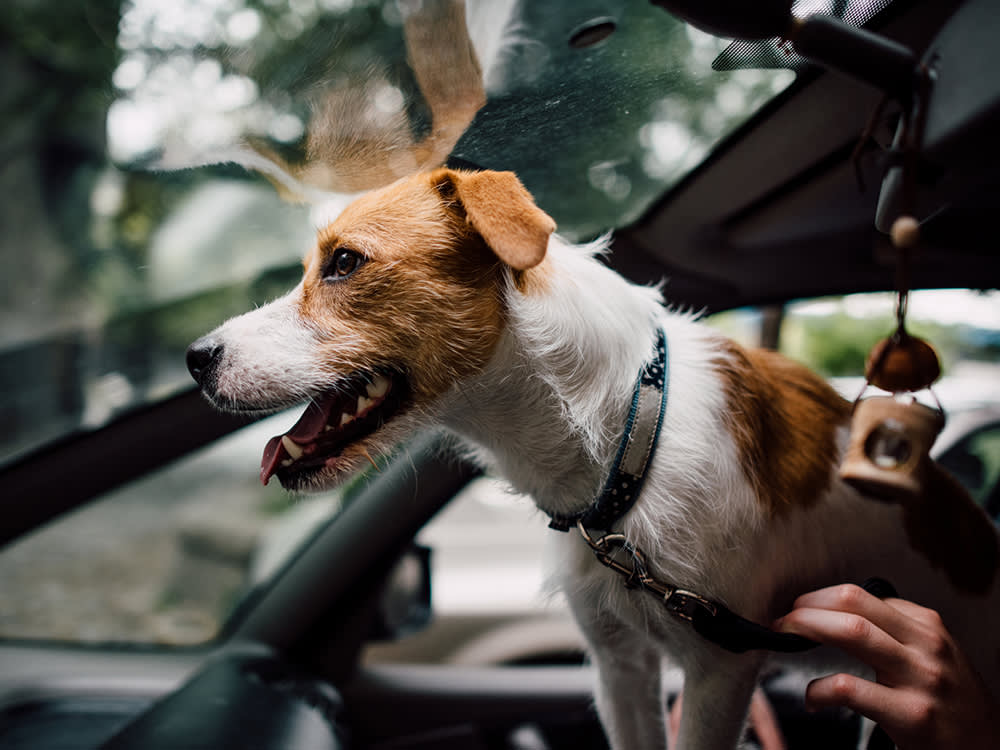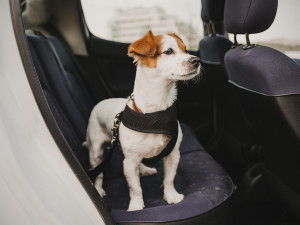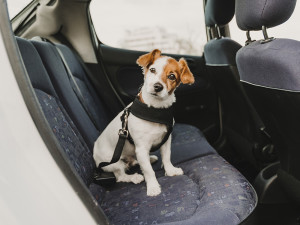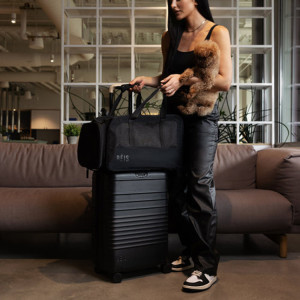More States Should Definitely Have Dog Seat Belt Laws
Car travel with an unrestrained dog just isn’t safe. For anyone.

Share Article
Does the thought of seeing a dog with their head hanging out of a driving car bring you joy? No doubt — this image is such a happy one for a reason. Wouldn’t we all want to stick our heads out of the window and feel the breeze on a sunny day? But, and sorry to be a total bummer right now; if you see this, it probably means the dog isn’t restrained, and that’s not good.
Having a pup unrestrained in the car — whether in your lap or curled up in the back seat — can cause them (and you) serious injuries. In some states, it’s illegal to drive with your dog unrestrained in the car. Plus, a 2019 studyopens in a new tab published in Preventative Medicine Magazine, following a survey of United States dog parents, found that only 55 percent of dog parents in the U.S. restrain their dogs. And, even then, American dog parents said they most often used a crateopens in a new tab to restrain their dogs in the car.
Distracted driving with dogs
Christina Selter, a nationally recognized pet safety expert, is all too familiar with the dangers and distractions posed by dogs who aren’t buckled up when riding in a vehicle. “Unrestrained pets can cause accidents,” says Selter, founder of the California-based educational group Bark Buckle UP. “I can think of two accidents that were caused by [unrestrained] dogs in the front seat. In one, the owner looked over at her dog and, in a split second, hit a driver in another lane.”

Get (totally free) deals for food, treats, accessories, tech and way more pet parenting must-haves.
opens in a new tabGeorgia coroner Vernon Collins can’t shake the images of a head-on collision that claimed the lives of two women and a dog. Collins says that one of the drivers, who was apparently distracted by the Chihuahua mix on her lap, swerved and crashed into a car in the other lane. The margin for error is indeed very, very small. Accordingopens in a new tab to the AAA Foundation for Traffic Safety, drivers who take their eyes off the road for just two seconds double their risk of becoming involved in an accident.
A 2011 surveyopens in a new tab by AAA and Kurgo products revealed that pet parents nationwide are often distracted by their four-legged pals. One in five reported taking their hands off the steering wheel to prevent a pup from climbing into the front seat. In the survey of 1,000 pet parents, 31 percent admitted to being distracted by their pet while driving. It also uncovered other behaviors that increase a driver’s risk of crashing, including:
Petting a dog (52 percent)
Holding a dog while applying the brakes (23 percent)
Allowing a dog to sit in their lap (17 percent)
Giving a dog food or treats (13 percent)
Nearly all the dog parents surveyed in the AAA study — a whopping 83 percent — acknowledged that unrestrained dogs in moving vehicles are dangerous. In 2020, distracted drivers, including those interacting with their pets, caused 2,880 fatal crashes, according to police and government statistics.
That statistic worries Katherine Miller, the ASPCA’s applied science and research director. “A large percentage of dogs are traveling unrestrained in cars,” she observes.“Unrestrained pets are hugely distracting, particularly if they’re in the front seat. They can hit the dashboard or the windshield in an accident; if the airbag deploys, a dog in the front seat can be crushed.” And the risks don’t stop there.
The Trouble of Unrestrained Dogs in Cars
“An unrestrained dog can become a projectile during an accident,” says Jim Amormino, public information officer for the Orange County, California Sheriff’s Department. “Let’s say you have a dog [unrestrained] in the back seat, and you slam on your brakes. The dog is thrown forward into the driver or the windshield. That could cause serious injury to the driver or cause the driver to [lose control and] collide with another car. It’s just dangerous not to buckle up dogs in vehicles.”
Dogs are also at risk in other ways. Captain Linda D’Orsi with the Chula Vista, California, Fire Department has seen dogs in auto accidents bolt into traffic and hit by other cars. “A [pet parent] was in a freeway accident, and she and her dog survived. But the dog was not crated and got out of the car. And he was killed.”
D’Orsi, who is also FEMA-certified as a handler for urban search-and-rescue dogs, warns that unrestrained dogs have been known to flee from an accident scene and disappear forever. “A woman got in a traffic accident and was going to be taken away in an ambulance,” she says. “She had [an unrestrained] dog in the car with her, and the dog got out and ran in the road. He was spooked, and we could not coax him back.”
Law enforcement officials report that dogs may try to prevent paramedics from treating an injured driver or passengers. “For many dogs, their first duty is to protect their owner,” Amormino says. “If you��’re trying to rescue a sick or injured person and the dog is trying to protect [that person], emergency response and treatment can be delayed.”
The key to preventing these problems is to get dogs off drivers’ laps and out of the front seat. Ideally, they should be in the back seat in a safely secured crate or restrained by a seat beltopens in a new tab, tether, or harness. As Selter notes, “We buckle up our kids, we buckle up ourselves, and even our groceries. Why are we not buckling up our pets?”
Dog Seat Belt Laws
Currently, no federal law requires pets to be restrained inside a vehicle, and of the 50 states, only Hawaii prohibits motorists from driving with pets on their laps. Below are a few of the states with notable laws on the books.
California
While a crate is required if you’re transporting your dog in a pickup truck in California, no lawsopens in a new tab currently require a seat belt or restraint inside a car.
Connecticut
You might get into hot water if you drive with your dog on your lap in Connecticut because their distracted driving laws define it as “any non-driving activity a person engages in while operating a motor vehicle.” If you drive with your dog in a truck bed, they are required by law to be in a crate.
Hawaii
In Hawaii, driving with your dog in your lap is illegal; your dog is also required to be restrainedopens in a new tab with a seatbelt or crate when in a moving car.
Maine
If you are driving with your dog in a convertible or pickup truck in Maine, you’ll be required to use a pet restraint or crate. Maine distracted driving law also prohibits any activity “that actually impairs, or would reasonably be expected to impair, the ability of the person to safely operate the vehicle.”
Michigan
At the local government level, Troy, Michigan, passed a “no dogs on drivers’ laps” ordinance that took effect on January 1, 2011. A House opens in a new tabbill has been introduced that would make driving with a dog on your lap illegal, but it hasn’t been passed.
Massachusetts
Like California, in Massachusetts, you are prohibited from transporting your dog in a truck bed without a crate unless the sides of the pickup bed are at least 46 inches. Drivers can also be fined if it seems that they are transporting their animal in a way that puts them in danger or if it seems the dog is interfering with safe driving.
New Hampshire
New Hampshire is another state that only has dog restraint laws relating to pickup trucks. There, you’ll be required to use a crate. There are currently no laws for dogs traveling inside cars.
New Jersey
New Jersey has the strictest dog seat belt laws in the country. Driving with unrestrained pets in a vehicle in New Jersey is considered an animal cruelty law violation. Drivers can face fines ranging from $50 to $1000 or, in some cases, six months in jail.
Rhode Island
In Rhode Island, dogs must be restrained in an open-air car such as a convertible or pickup truck with a seat belt or crate.
Vermont
In Vermont, there are no explicit laws against driving with a dog in the car, but it’s illegal to transport pets in an inhumane way. Best to use a seat belt.
Driving with your dog? Here are some safety tips:
Keep dogs in the back seat and make it a habit to restrain them with a pet harness or tether, or in a crateopens in a new tab; if using a harnessopens in a new tab, choose one that’s easy to put on the dog.
Tether crates to be sure they’re secure because crates themselves can also become projectiles.
Make sure the pet restraint you select has been crash-testedopens in a new tab in the U.S. (Some are tested outside the U.S., so different standards may apply.)

Lisa McCormick
Lisa McCormick is an award-winning investigative reporter whose stories have appeared in Dogs for Kids magazine, The Kansas City Star, and the national consumer news website, ConsumerAffairs.com; she has written 12 nonfiction children's books.


